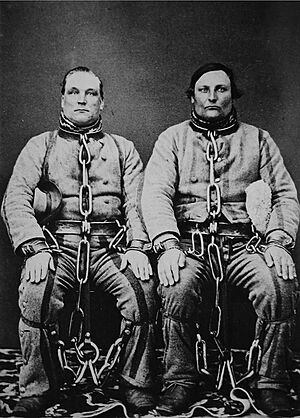Imprisonment facts for kids
Imprisonment or incarceration is the restraint of a person's liberty against their will. Imprisonment could be given for any cause whatsoever, whether by authority of the government, or by a person acting without such authority. In the latter case it is considered "false imprisonment". Imprisonment does not necessarily imply a place of confinement, with bolts and bars, but may be exercised by any use or display of force (such as placing one in handcuffs), lawfully or unlawfully, wherever displayed, even in the open street. People become prisoners, wherever they may be, by the mere word or touch of a duly authorized officer directed to that end. Usually, however, imprisonment is understood to imply actual confinement in a prison employed for the purpose according to the provisions of the law. Generally gender imbalances occur in imprisonment rates, with incarceration of males proportionately more likely than incarceration of females.
History
Africa
Before colonisation, imprisonment was used in sub-Saharan Africa for pre-trial detention, to secure compensation and as a last resort but not generally as punishment, except in the Songhai Empire (1464–1591) and in connection with the slave trade. In the colonial period, imprisonment provided a source of labor and a means of suppression. The use of imprisonment has continued to the present day.
Australia
Incarceration in what became known as Australia was introduced through colonization. As noted by scholar Thalia Anthony, the Australian settler colonial state has engaged in carceral tactics of containment and segregation against Aboriginal Australians since colonizers first arrived, "whether that be for Christian, civilizing, protectionist, welfare, or penal purposes." When settlers arrived, they invented courts and passed laws without consent of Indigenous peoples that stated that they had jurisdiction over them and their lands. When Indigenous peoples challenged these laws, they were imprisoned.
England and Wales
In English law, imprisonment is the restraint of a person's liberty. The 17th century book Termes de la Ley contains the following definition:
Imprisonment is no other thing than the restraint of a man's liberty, whether it be in the open field, or in the stocks, or in the cage in the streets or in a man's own house, as well as in the common gaols; and in all the places the party so restrained is said to be a prisoner so long as he hath not his liberty freely to go at all times to all places whither he will without bail or mainprise or otherwise.
Imprisonment without lawful cause is a tort called false imprisonment. In England and Wales, a much larger proportion of the black population is imprisoned than of the white.
Release
When a prisoner completes serving their sentence, start probation, or is given a compassionate release they are no longer considered prisoners and are released to the outside world. A prisoner of war may be released as a result of the end of hostilities or a prisoner exchange. Prisoners serving a full life or indefinite sentence may never be released.
Released prisoners may suffer from issues including psychiatric disorders, criminalized behaviours and access to basic needs. Some criminals, particularly criminals convicted of serious crimes (felonies or indictable offenses,) are given restrictions after release, including bans from buying firearms or jury duty exclusion. Post release resources may be provided by the authorities.
See also
 In Spanish: Prisión para niños
In Spanish: Prisión para niños
- Criminal justice
- Detention (imprisonment)
- Imprisonment for public protection
- Life imprisonment
- List of countries by incarceration rate
- Prison
- Prisoner of war
- Rehabilitation (penology)
- Restorative justice


